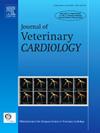Quantitative methods for evaluation of mitral regurgitation severity in canine degenerative mitral valve disease
IF 1.3
2区 农林科学
Q2 VETERINARY SCIENCES
引用次数: 0
Abstract
Introduction/objectives
Quantitative assessment of mitral regurgitation (MR) severity has become increasingly important as procedural therapies for MR reduction become available. This study aimed to obtain quantitative measures of MR severity across stages of degenerative mitral valve disease (DMVD) and evaluate agreement between two echocardiographic methods.
Animals, materials and methods
Fifty-one client-owned dogs were included across three DMVD stages (ACVIM B1, B2, and C). Regurgitant volume (RVol) and fraction (RF) were measured on echocardiograms prospectively acquired by a single cardiologist using volumetric (using Simpson's method of discs) and proximal isovelocity surface area (PISA) methods. Results were compared across stages. Agreement between methods over the range of MR severity was determined by Bland–Altman analyses. Intra- and inter-observer measurement variability assessments were performed via intraclass correlation coefficients (ICC).
Results
Median differences (25th percentile, 75th percentile) for volumetric and PISA-derived RVol and RF were as follows, respectively: B1:0.19 mL/kg (−0.02 mL/kg, 0.25 mL/kg), 13.6% (−2.17%, 20.6%); B2:1.49 mL/kg (1.09 mL/kg, 2.12 mL/kg), 55.6% (45.0%, 70.5%); C:2.72 mL/kg (1.76 mL/kg, 3.13 mL/kg), 67.2% (61.8%, 78.5%); B1:0.39 mL/kg (0.22 mL/kg, 0.69 mL/kg), 34.3% (19.0%, 56.1%); B2:1.67 mL/kg (1.33 mL/kg, 2.15 mL/kg), 58.8% (49.8%, 73.9%); C:3.1 mL/kg (1.91 mL/kg, 3.57 mL/kg), 75.2% (66.4%, 92.0%). All were different (P<0.0001) across stages. There was no proportional bias for RVol or RF (P=0.79, P=54). Intra- and inter-observer variability assessments showed ICC greater than 0.75 except PISA RF.
Conclusions
Measures of MR severity correlate with disease stage, although their accuracy remains unknown. Volumetric and PISA methods are not interchangeable.
犬退行性二尖瓣病变二尖瓣反流严重程度的定量评价方法
随着二尖瓣返流(MR)降低的程序性治疗的出现,对其严重程度的定量评估变得越来越重要。本研究旨在获得退行性二尖瓣疾病(DMVD)各阶段MR严重程度的定量测量,并评估两种超声心动图方法之间的一致性。动物、材料和方法51只客户拥有的狗分为三个DMVD阶段(ACVIM B1、B2和C)。在超声心动图上测量反流体积(RVol)和分数(RF),这些超声心动图是由一名心脏病专家使用容积法(使用辛普森圆盘法)和近端等速度表面积(PISA)方法前瞻性地获得的。各阶段的结果比较。通过Bland-Altman分析确定了不同方法在MR严重程度范围内的一致性。通过类内相关系数(ICC)对观察者内部和观察者之间的测量变异性进行评估。结果容积法和pisa法RVol和RF的中位数差异(25百分位数,75百分位数)分别为:B1:0.19 mL/kg (- 0.02 mL/kg, 0.25 mL/kg), 13.6% (- 2.17%, 20.6%);B2:1.49 mL / kg(1.09毫升/公斤,2.12毫升/公斤),55.6% (45.0%,70.5%);C: 2.72毫升/公斤(1.76毫升/公斤,3.13毫升/公斤),67.2% (61.8%,78.5%);B1:0.39 mL / kg(0.22毫升/公斤,0.69毫升/公斤),34.3% (19.0%,56.1%);B2:1.67 mL / kg(1.33毫升/公斤,2.15毫升/公斤),58.8% (49.8%,73.9%);C: 3.1毫升/公斤(1.91毫升/公斤,3.57毫升/公斤),75.2%(66.4%,92.0%)。各个阶段的结果都不同(P<0.0001)。RVol和RF均无比例偏倚(P=0.79, P=54)。观察者内部和观察者之间的变异性评估显示,除PISA RF外,ICC大于0.75。结论MR严重程度的测量与疾病分期相关,尽管其准确性尚不清楚。容积法和PISA方法是不可互换的。
本文章由计算机程序翻译,如有差异,请以英文原文为准。
求助全文
约1分钟内获得全文
求助全文
来源期刊

Journal of Veterinary Cardiology
VETERINARY SCIENCES-
CiteScore
2.50
自引率
25.00%
发文量
66
审稿时长
154 days
期刊介绍:
The mission of the Journal of Veterinary Cardiology is to publish peer-reviewed reports of the highest quality that promote greater understanding of cardiovascular disease, and enhance the health and well being of animals and humans. The Journal of Veterinary Cardiology publishes original contributions involving research and clinical practice that include prospective and retrospective studies, clinical trials, epidemiology, observational studies, and advances in applied and basic research.
The Journal invites submission of original manuscripts. Specific content areas of interest include heart failure, arrhythmias, congenital heart disease, cardiovascular medicine, surgery, hypertension, health outcomes research, diagnostic imaging, interventional techniques, genetics, molecular cardiology, and cardiovascular pathology, pharmacology, and toxicology.
 求助内容:
求助内容: 应助结果提醒方式:
应助结果提醒方式:


